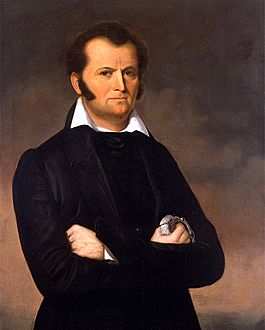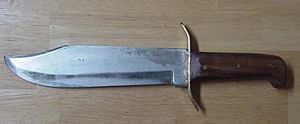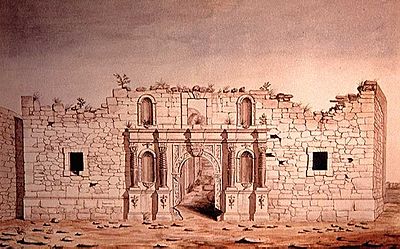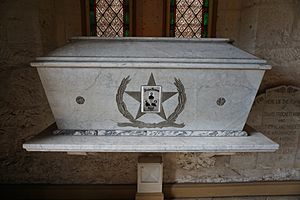James Bowie facts for kids
Quick facts for kids
James "Jim" Bowie
|
|
|---|---|

Bowie c. 1831-1834
|
|
| Nickname(s) | Jim Bowie, Santiago Bowie |
| Born | c. 1796 Logan County, Kentucky, U.S. |
| Died | March 6, 1836 Alamo Mission, San Antonio, Texas |
| Allegiance | Republic of Texas |
| Years of service | 1835–1836 |
| Rank | Colonel |
| Unit | Texian volunteer army |
| Commands held | The Alamo, San Antonio |
| Battles/wars | Texas Revolution
|
| Signature | |
James Bowie (pronounced BOO-ee) was an American pioneer and soldier. He played a big part in the Texas Revolution. He is famous for his special knife, the Bowie knife. Bowie was one of the brave Americans who died at the Battle of the Alamo. His stories, both true and made-up, have made him a legendary figure in Texas history. He is also a folk hero in American culture.
Bowie was born in Kentucky. He lived most of his life in Louisiana. There, he grew up and later worked with land. He became well-known in 1827 after a fight called the Sandbar Fight. This fight started as a duel but turned into a big brawl. Bowie was hurt but defended himself.
Bowie's fame grew during the Texas Revolution. He moved to Texas in 1830. He became a Mexican citizen and married Ursula Veramendi. She was the daughter of the Mexican vice-governor. Bowie led a trip to find a lost mine. His small group fought off a large Native American attack. This made him even more famous.
When the Texas Revolution began, Bowie joined the Texas militia. He led troops in the Battle of Concepción and the Grass Fight. In January 1836, he arrived at the Alamo. He commanded the volunteer soldiers there. But he became very ill and was bedridden. Bowie died on March 6, 1836, with the other Alamo defenders. Most stories say he died in his bed while fighting Mexican soldiers.
Contents
Early Life and Family Background
James Bowie was born on March 10, 1796, in Logan County, Kentucky. His last name, Bowie, is pronounced BOO-ee. He was the ninth of ten children. His parents were Reason and Elve Bowie. His father fought in the American Revolutionary War.
The Bowie family moved often when James was young. They lived in Georgia, Kentucky, Missouri, and Louisiana. In 1802, they settled in Rapides Parish, Louisiana. By 1812, they found a permanent home in Opelousas.
Growing up on the frontier, the Bowie children learned many skills. They helped clear land and farm. All the children learned to read and write English. James and his older brother Rezin also learned to read, write, and speak Spanish and French. They learned to fish, butcher meat, and run a farm. James Bowie became very good with pistols, rifles, and knives. He was known for being fearless. As a boy, a Native American friend taught him to rope alligators.
In late 1814, James and Rezin joined the Louisiana militia. They wanted to fight the British in the War of 1812. But they arrived in New Orleans too late for the main battle. After leaving the militia, Bowie lived in Rapides Parish. He earned money by cutting lumber and selling it. In June 1819, he joined the Long Expedition. This group tried to free Texas from Spanish rule. They took Nacogdoches and declared Texas independent. Bowie returned to Louisiana before Spanish troops stopped the invasion.
Land and Business Ventures
Around 1820, James and Rezin Bowie received land and animals from their father. For the next seven years, they worked together. They developed large estates in Lafourche Parish and Opelousas. Louisiana's population was growing fast. The brothers hoped to make money from rising land prices.
In 1825, the brothers bought Acadia Plantation. It was near Thibodaux. Within two years, they built Louisiana's first steam mill for grinding sugar cane. Their plantation was seen as a great example of farming. In 1831, they sold it for $90,000. With their profits, James and Rezin bought another plantation in Arkansas.
The Famous Bowie Knife
What Caused the Sandbar Fight?
Bowie became famous because of a fight with Norris Wright. Wright was the sheriff of Rapides Parish. Bowie had supported Wright's opponent for sheriff. Also, Wright, who was a bank director, had denied Bowie a loan. One day in Alexandria, Wright shot at Bowie. After this, Bowie decided to always carry his hunting knife. This knife had a blade about 9.25 inches (23.5 cm) long and 1.5 inches (3.8 cm) wide.
The Sandbar Fight of 1827
On September 19, 1827, Bowie and Wright went to a duel. It was on a sandbar near Natchez, Mississippi. Bowie was there to support one of the duelists. Wright supported the other. The duelists fired shots but were not hurt. They shook hands and ended their duel. But other people in their groups, who disliked each other, started fighting.
During the fight, someone knocked Bowie to the ground. Wright shot at Bowie but missed. Bowie fired back and may have hit Wright. Wright wounded Bowie. Bowie then pulled Wright down and killed him. Doctors at the duel treated Bowie's injuries.
Newspapers reported the story. They called it the Sandbar Fight. They wrote about Bowie's fighting skills and his unusual knife. Witnesses said Bowie did not attack first. Others focused on attacking Bowie because they saw him as "the most dangerous man." After this, Bowie became known as a superb knife fighter across the South.
Designing the Bowie Knife
Experts disagree on who designed the first Bowie knife. Some say Bowie designed it himself. Others say famous knife makers did. His brother Rezin claimed he designed the knife. Many of Bowie's family members and knife experts believe Rezin invented it. However, Rezin Bowie's grandchildren said Rezin only watched his blacksmith, who was the true designer.
After the Sandbar Fight, the Bowie knife became very popular. Many people started making their own versions. Big cities in the Old Southwest even had "Bowie knife schools." These schools taught people how to use the knife for fighting. Bowie's fame and his knife's fame spread to Great Britain. By the early 1830s, British companies were making Bowie knives to sell in the United States.
The design of the knife changed over time. Today, a Bowie knife usually has a blade about 8.25 inches (21 cm) long and 1.25 inches (3.2 cm) wide. It has a curved point and a sharp false edge on both sides. It also has a guard to protect the user's hands.
Life in Texas
In 1828, Bowie moved to Coahuila y Texas. This was a state in the Mexican federation at the time. The Mexican Constitution of 1824 allowed only Roman Catholicism. It also favored Mexican citizens for land grants. Bowie became a Roman Catholic in San Antonio on April 28, 1828. His sponsors were the town's chief administrator, Juan Martín de Veramendi, and his wife.
On January 1, 1830, Bowie moved to Texas for good. He stopped in Nacogdoches and San Felipe. He then went to San Antonio de Bexar. This city had about 2,500 people, mostly Mexican. Bowie spoke Spanish well, which helped him settle in.
Bowie was chosen as a commander of the Texas Rangers that year. He held the rank of colonel. The Rangers were not officially organized until 1835. But Stephen F. Austin had started the group. He hired 30 men to keep peace and protect colonists from Native American attacks. Bowie commanded a group of these volunteers.
Bowie gave up his American citizenship and became a Mexican citizen on September 30, 1830. He promised to build textile mills in Coahuila y Tejas. He partnered with Veramendi to build cotton and wool mills. As a citizen, Bowie could buy large amounts of public land. He convinced other citizens to apply for land and transfer it to him. This gave him 700,000 acres (280,000 ha) for land deals.
On April 25, 1831, Bowie married Maria Ursula de Veramendi. She was 19 years old and the daughter of his business partner. Before the wedding, he promised to pay her 15,000 pesos within two years. Bowie claimed to be worth $223,000, mostly in land. He also lied about his age, saying he was 30 instead of 35.
The couple built a house in San Antonio. Later, they moved into the Veramendi Palace with Ursula's parents. They had two children, Marie Elve and James Veramendi Bowie. Sadly, Maria Ursula, her parents, and both children died in September 1833. A cholera epidemic swept through the area. Bowie was away on business and did not hear of their deaths until November.
Searching for the Lost Mine
After his marriage, Bowie became very interested in the "lost" Los Almagres Mine. It was also called the lost San Saba Mine. Legend said it was northwest of San Antonio, near the old Mission Santa Cruz de San Sabá. Native Americans supposedly worked the mine before the Spanish took it. After Mexico became independent, interest in mining decreased. Many Native American groups lived in the area. Without soldiers to keep them away, mining was very dangerous.
Bowie got permission from the Mexican government to search for the mine. On November 2, 1831, he, his brother Rezin, and ten others set out. Six miles (10 km) from their goal, they met a large group of Native Americans. There were more than 120 Tawakoni and Waco, plus 40 Caddo. Their talks failed. Bowie and his group fought for 13 hours. Bowie's group lost only one man. Over 40 Native Americans were killed, and 30 were wounded.
Meanwhile, friendly Comanche riders told San Antonio about the large raiding party. They thought Bowie's group must have died. Ursula Bowie even started wearing clothes for mourning. But to everyone's surprise, the survivors returned to San Antonio on December 6. Bowie's report of the trip was printed in newspapers. This made his reputation even stronger. He went out again the next month with more men. But he returned empty-handed after two and a half months.
Bowie rarely talked about his adventures. Captain William Y. Lacey, who lived with Bowie in the wilderness, said he was a humble man.
Bowie's Role in the Texas Revolution
Rising Tensions in Texas
Between 1830 and 1832, Mexico passed laws that seemed unfair to Anglo colonists in Texas. This caused tension between the colonists and Mexican officials. Mexican troops set up military posts in Texas, including San Antonio. In 1832, Antonio López de Santa Anna led a revolt against the Mexican president. Anglo colonists in Texas supported Santa Anna.
In July 1832, Bowie heard that the Mexican army commander in Nacogdoches, José de las Piedras, wanted all residents to give up their weapons. Bowie quickly returned to Texas. On August 2, 1832, he joined other Texans. They marched into Nacogdoches to "present their demands" to Piedras. Before they reached the town officials, 100 Mexican cavalry attacked them. The Texans fought back, starting the Battle of Nacogdoches. After the cavalry retreated, the Texans surrounded the Mexican garrison. After a second fight, the Mexican army left during the night. Bowie and 18 men ambushed the fleeing army. They marched the soldiers back to Nacogdoches. Bowie later attended the Convention of 1833. This meeting formally asked for Texas to become its own state within Mexico.

Months later, a cholera epidemic hit Texas. Bowie sent his pregnant wife and daughter to her family's estate in Monclova. Her parents and brother went with them. The cholera epidemic reached Monclova. Between September 6 and 14, Ursula, their children, her brother, and her parents all died. Bowie was away on business and did not learn of their deaths until November.
The next year, Mexico allowed land sales in Texas. Bowie went back to land speculation. He was appointed a land commissioner. His job was to help people settle in an area bought by John T. Mason. His appointment ended in May 1835. President Antonio López de Santa Anna ended the Coahuila y Tejas government. He ordered the arrest of all Texans doing business in Monclova, including Bowie. Bowie had to flee Monclova and return to the Anglo areas of Texas.
The Anglos in Texas began pushing for war against Santa Anna. Bowie worked with William B. Travis, a leader of the War Party. Bowie visited Native American villages in East Texas. He tried to convince them to fight against the Mexican government. Santa Anna responded by sending many Mexican troops to Texas.
Battles of Concepción and Grass Fight
The Texas Revolution started on October 2, 1835, with the Battle of Gonzales. Stephen F. Austin formed an army of 500 men. They marched on Mexican forces in San Antonio. On October 22, Austin asked James W. Fannin and Bowie to scout the area. Bowie was now a colonel in the volunteer militia. They were to find supplies near the missions of San Francisco de la Espada and San José y San Miguel de Aguayo. The scouting party had 92 men, including many from the New Orleans Grays. They found a good defensive spot near Mission Concepción. They asked Austin's army to join them.
On October 28, Mexican General Domingo Ugartechea attacked. He had 300 infantry and cavalry soldiers and two small cannons. The Texian forces were in a good defensive spot. The Mexican army got within 200 yards (183 m). But the Texian position protected them. When the Mexicans reloaded their cannon, the Texans climbed a bluff. They shot at some of the soldiers. Bowie led a charge to capture one of the Mexican cannons. It was only 80 yards (73 m) away. Ugartechea retreated with his troops. This ended the Battle of Concepción. One Texian and ten Mexican troops were killed. One of Bowie's men praised him as a "born leader." He said Bowie never wasted bullets or risked lives. He told them, "Keep under cover boys, and reserve your fire; we haven't a man to spare."
An hour after the battle, Austin arrived with the rest of the Texian army. They began a siege of San Antonio de Béxar. General Martín Perfecto de Cós, the Mexican commander, and his troops were there. Two days later, Bowie left Austin's army. He did not have an official commission. He also disliked "minor tasks of scouting and spying."
On November 3, 1835, Texas declared itself an independent state. A temporary government was formed. Henry Smith was elected provisional governor. Austin asked to leave his command. Sam Houston was named army chief. Edward Burleson became temporary commander of the troops in San Antonio. Bowie asked the council for a commission. But they refused, likely because of his past land dealings.
Houston offered Bowie an officer's commission on his staff. But Bowie said no. He wanted to be in the middle of the fighting. Instead, Bowie joined the army as a private under Fannin. He again showed his bravery in the Grass Fight on November 26. Cós had sent about 187 men to cut grass for his horses. As they returned to San Antonio, Bowie took 60 mounted men to stop them. They thought the Mexicans carried valuable cargo. The Mexican troops sped up to reach the city's safety. But Bowie and his cavalry chased them. At the end of the fight, the Texans had two wounded men. But they captured many horses and mules.
Soon after Bowie left San Antonio, Ben Milam led an attack on the city. The Texans had few casualties. The Mexican army lost many troops to death and desertion. Cós surrendered and returned to Mexico. He took the last Mexican troops in Texas with him. Many Texian volunteers thought the war was over. They left the army and went home. In early January 1836, Bowie went to San Felipe. He asked the council to let him recruit a regiment. He was turned down again. They said he "was not an officer of the government nor army."
The Battle of the Alamo
Houston heard that Santa Anna was leading a large force to San Antonio. Bowie offered to lead volunteers to defend the Alamo. He arrived with 30 men on January 19. They found 104 men with few weapons, cannons, supplies, or gunpowder. Houston knew they could not hold the fort. He told Bowie to remove the artillery and blow up the fort. But Bowie and the Alamo commander, James C. Neill, decided they did not have enough oxen to move the artillery. They also did not want to destroy the fortress. On January 26, one of Bowie's men, James Bonham, organized a rally. They voted to hold the Alamo. Bonham signed first, then Bowie.
Bowie spoke Spanish well. His marriage also gave him connections. So, the Mexican people of San Antonio often gave him information. He learned that Santa Anna had 4,500 troops and was coming to the city. Bowie wrote letters to the temporary government. He asked for help to defend the Alamo. He needed "men, money, rifles, and cannon powder." In a letter to Governor Smith, he wrote that "the salvation of Texas depends in great measure on keeping Béxar out of the hands of the enemy." He added, "Colonel Neill and myself have come to the solemn resolution that we will rather die in these ditches than give it up to the enemy."
On February 3, Davy Crockett arrived with thirty men from Tennessee. Neill left on February 11 to visit his sick family. This left Travis, a regular army member, in command. Bowie was older than Travis. He had a better reputation and saw himself as a colonel, outranking Travis. Bowie refused to take orders from Travis. Travis called an election for the men to choose their commander. They chose Bowie, which made Travis angry. Bowie celebrated by causing trouble in San Antonio. He released prisoners and bothered citizens. Travis was upset. But two days later, the men agreed to share command. Bowie would lead the volunteers, and Travis would lead the regular army and cavalry.
On February 23, the bells of San Fernando rang. This warned of the Mexican army's approach. Travis ordered all Texan forces into the Alamo. Bowie quickly gathered supplies and herded cattle into the Alamo. Bowie invited his wife's cousins, Getrudis Navarro and Juana Navarro Alsbury, to stay inside the Alamo. Alsbury's 18-month-old son also came. Bowie also brought several black servants into the fort. Bowie had been ill. Two doctors could not figure out his illness. Travis became the only commander when Bowie was confined to bed. Santa Anna and his army began a siege of the Alamo on February 24. The Mexican army raised a red flag. This meant no mercy would be given.
Bowie and Travis sent out messengers. They asked for supplies and help. On February 25, Travis sent Juan Seguin on Bowie's horse to get more soldiers. Thirty-two more men arrived. On February 26, Crockett reported that Bowie, though sick, still crawled from his bed each day. He showed himself to the Alamo's defenders. This greatly boosted their spirits.
Thirty-five years after the Alamo fell, a reporter said Louis "Moses" Rose was the only man to have "deserted" the Texan forces. According to Rose's story, Travis drew a line in the sand. He asked those willing to die to cross it. At Bowie's request, Crockett and others carried his cot over the line. Rose was left alone on the other side. After this article, other witnesses confirmed the story. But since Rose was dead, the story relies on the reporter's word. The reporter admitted to making up parts of other articles. So, many historians do not believe this story.
Bowie died with the other Alamo defenders when the Mexicans attacked on March 6. Most non-fighters in the fort, including Bowie's relatives, survived. Santa Anna ordered the alcalde of San Antonio, Francisco Antonio Ruiz, to identify Bowie, Travis, and Crockett.
When Bowie's mother heard of his death, she calmly said, "I'll wager no wounds were found in his back." One year after the battle, Juan Seguin returned to the Alamo. He gathered the remaining ashes from the funeral pyre. He put them in a coffin with the names of Bowie, Travis, and Crockett. The ashes were buried at the Cathedral of San Fernando.
Bowie's Legacy
Even though Bowie claimed to be rich, his estate was very small. His belongings were sold for only $99.50. His greater legacy is his place as "one of the legendary characters of the American frontier." Bowie left very few written records of his life. So, "where history failed, the legends prevailed." Bowie and his knife were well known during his life. But his legend grew after October 1852. That's when DeBow's Review published an article by his brother, John Jones Bowie. It was called "Early Life in the Southwest—The Bowies." The article mostly focused on Jim Bowie's adventures. After that article, "romanticized stories" about Bowie appeared in national newspapers. Many of these stories were "pure melodrama." They showed Bowie rescuing innocent people.
Jim Bowie was added to the Blade Magazine Cutlery Hall of Fame in 1988. This was because his knife design influenced many knife makers and companies.
Many films have shown the Battle of the Alamo. Bowie has been a character in each one.
Alan Ladd played Bowie in The Iron Mistress (1952). This film ends with his marriage and does not show the Battle of the Alamo.
From 1956 to 1958, Bowie was the subject of a CBS television series. It was called The Adventures of Jim Bowie. The show starred Scott Forbes as Jim Bowie. It was based on the 1946 novel Tempered Blade.
The rock star David Bowie (born David Robert Jones) took his last name from James Bowie. Jones changed his name in the 1960s. He did not want to be confused with Davy Jones of The Monkees. He chose Bowie because he admired James Bowie and the Bowie knife.
Bowie County in northeast Texas is named after James Bowie. The city of Bowie in Montague County, Texas, is also named in his honor. James Bowie Elementary in Corsicana, Texas was also named after him.
Images for kids
See also
 In Spanish: James Bowie para niños
In Spanish: James Bowie para niños






